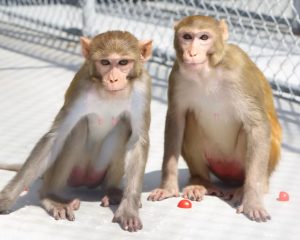Animal in Research
Texas Biomedical Research Institute’s Southwest National Primate Research Center has a long-standing commitment to treating its animals humanely and with the highest regard for their well-being. SNPRC works closely with regulatory agencies to determine best practices to enhance care provided to the primates, for the sake of the animals and the quality of the 
While some research questions may be adequately addressed using cell cultures, tissue studies or computer models (which we also employ at Texas Biomed and the SNPRC), research with animals continues to be critical for the advancement of human health. Disease processes are complex, involving multiple physiological processes and multiple organ systems that simply require the use of complex models.
Virtually every major advance in medical knowledge and treatment has involved research using animal models. Animal research has saved lives, extended life expectancy, and improved the quality of life for both humans and animals by enabling scientists to conduct critical experiments that identified ways to prevent, treat, and cure disease.
Although less than 0.5 percent of all animals used in research are primates, work with these animals is important to scientific understanding of human health and disease. Future medical progress depends on this continued research
Research involving animals is evaluated and monitored closely at the SNPRC. An internal IACUC committee of scientists, veterinarians and even a community member reviews all requests involving the use of animals in research and requires justification of the choice of animal to be used, the numbers of animals to be used and the proposed treatment of the animals. This committee also has the authority to prevent a research program from being initiated or to stop a research program if the committee determines that an investigator is not complying with the regulations or guidelines for the care and use of animals.
To understand the impact that animal research has had on all our lives, consider these examples of major medical breakthroughs that primate research has provided humanity:
- Most of the nation’s 1 million insulin-dependent diabetic individuals would not have insulin
- Sixty million Americans would risk death from heart attack, stroke or kidney failure from lack of medication for high blood pressure.
- Vaccines based on primate research have reduced the number of cases of polio in the United States from 58,000 to one or two per year.
Why are Primates so critical to life-saving research?
- Genetic and Physiological Similarities
Primates are genetically and physiologically more similar to humans than are other animal species. Use of nonhuman primate models allows investigation of complex physiological characteristics that are shared only by humans and other primates. - Infectious Disease Susceptibility Similarities
Only humans and other primates are susceptible to many of the infectious diseases that threaten human populations. For example, the chimpanzee is the only animal besides man that is susceptible to infection with hepatitis B and hepatitis C viruses. Unlike humans, however, chimpanzees do not develop liver disease from these infections. This characteristic makes chimpanzees a valuable model for hepatitis research. In fact, work with chimpanzees at Texas Biomed was instrumental in the development of a successful vaccine for hepatitis B, which is now given to school-age children. - Similarities in Chronic Disease Profiles
Primates more closely resemble humans than any other animal model in manifestations of the chronic diseases that are the major public health problems in the United States today. For example, nonhuman primates have naturally occurring atherosclerosis, osteoporosis and hypertension, making them ideal animal models for these conditions. - Ability to Control Matings
The ability to control breeding of nonhuman primates allows experimental testing of specific genetic hypotheses that is not possible in human populations. - Ability to Control Environment
Primates can be maintained in a similar environment throughout life. The ability to control and maintain environmental factors facilitates many experimental evaluations not possible in human populations.
Visit Americans for Medical Progress for more information
Benefits that Primate Research at Texas Biomed & SNPRC have provided to humanity
Studies with premature baboons enabled researchers to refine the technique of high-frequency oscillatory ventilation, which is used to save the lives of thousands of premature babies and minimize lung damage in these children.
Basic physiological research with premature baboons advanced the development of a natural product called Surfactant to prevent lung damage complications in premature newborn babies. Surfactant is now given to all premature infants as an aerosol.
Research with baboons and chimpanzees established that a mixture of specific proteins and a matrix material can dramatically hasten the restructuring of bone after surgery or accidental breakage. It is expected that this product will soon become widely used and that it will greatly reduce recovery time after bone breakage or surgery.
Much of the work involved in developing a hepatitis B vaccine was done with chimpanzees at Texas Biomed. Safety and efficacy testing of the first hepatitis B vaccine also was done at the Institute. An improved, safer vaccine has since been developed, and its efficacy also was established in research with chimpanzees at Texas Biomed.
Work done at Texas Biomed involving Rhesus Macaques has provided successful results in a treatment now being implemented in parts of Africa to curve the spread of Ebola.

